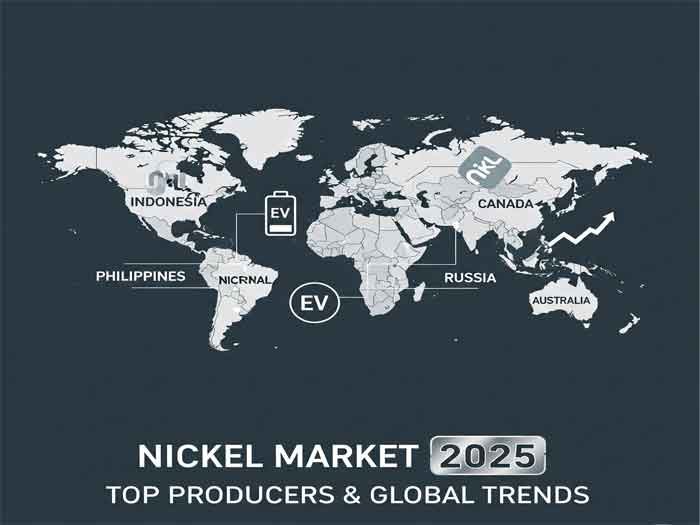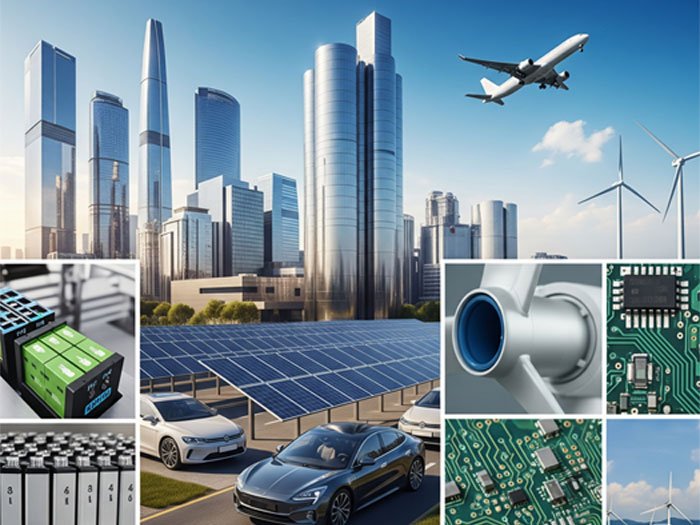Nickel Market Outlook 2025: Top Producers, Strategic Importance, and Global Supply Chain Trends
Nickel has emerged as a strategic metal in 2025, driven by its critical role in electric vehicle (EV) batteries, stainless steel, and clean energy technologies. As global industries pivot toward electrification and sustainability, understanding the nickel market—and the countries that dominate its production—has never been more important for investors, manufacturers, and policymakers.

Why Nickel Is a Strategic Metal in 2025
- EV Battery Revolution: Nickel is a core component in advanced lithium-ion batteries, especially those using Nickel-Manganese-Cobalt (NMC) chemistry. These batteries offer high energy density, longer range, and improved performance, making nickel indispensable for next-generation EVs.
- Stainless Steel & Industry: Beyond batteries, nickel is essential for stainless steel, aerospace, and electronics, ensuring durability and corrosion resistance in critical infrastructure.
- Demand Growth: Global nickel demand for EV batteries is growing at double-digit rates annually. By 2035, half of all new cars sold globally are projected to be electric, further accelerating nickel consumption.
- Geopolitical Stakes: Nickel supply is concentrated in a handful of countries, making the market vulnerable to geopolitical tensions, export restrictions, and regulatory changes.

Global Nickel Production: 2024 vs 2025 Trends
| Year | Global Nickel Production | Key Trends | Price (avg/ton) |
|---|---|---|---|
| 2024 | Oversupply, Indonesia-led growth | Price decline, supply outpaces demand | ~$15,32835 |
| 2025 | Continued oversupply, Indonesia expands | Prices dip further, but long-term outlook bullish | ~$15,078 |
- Supply Surge: Indonesia and China have driven a 15-20% annual growth in nickel supply since 2019, while the rest of the world has seen a decline 57.
- Price Volatility: Despite oversupply and falling prices in 2024–2025, analysts expect prices to rebound as demand outpaces supply by 2030 3.
- ESG & Supply Chain Risks: Environmental, social, and governance (ESG) concerns, coupled with supply chain disruptions, are shaping investment and procurement strategies 21.
Top 5 Nickel Mining Countries in 2025
| Rank | Country | Key Features |
|---|---|---|
| 🥇 1 | Indonesia | World’s largest producer; strict export bans; rapid domestic smelting growth; major players: PT Vale, Tsingshan; backbone of global EV supply chains715 |
| 🥈 2 | Philippines | Second-largest exporter; key mining in Caraga Region; faces environmental and regulatory challenges71 |
| 🥉 3 | Russia | Major reserves (Norilsk Nickel); affected by sanctions; pivoting to China and non-Western markets71 |
| 🏅 4 | Australia | High-grade mines in Western Australia; stable political climate; investments in green/ESG-compliant nickel72 |
| 🏅 5 | Canada | Longstanding infrastructure; focus on sustainable mining (Glencore, Vale Canada); key supplier to North America |
The Global Nickel Supply Chain in 2025
- Interconnected Supply: Indonesia and the Philippines mine most of the world’s nickel, but much of it is processed and refined in China before being distributed globally for battery and stainless steel production 75.
- China’s Dominance: China leads in nickel processing and consumption, leveraging its vast EV and stainless steel industries. This centralization gives China significant influence over global nickel flows and pricing 75.
- Supply Chain Complexity: Raw nickel often travels from Southeast Asian mines to Chinese refineries, then on to battery makers in Asia, Europe, and North America—creating a complex, interdependent supply network 71.
Challenges Facing Global Nickel Supply
- Environmental & Ethical Issues: Mining in Indonesia and the Philippines has raised concerns over deforestation, pollution, and local community impacts, prompting calls for stricter ESG standards12.
- Labor & Policy Risks: Strikes, regulatory shifts, and export bans (notably Indonesia’s) can disrupt supply and create global ripple effects17.
- Long-Term Mismatch: While current oversupply keeps prices low, the rapid growth in EV and clean energy demand could lead to shortages and price spikes by 2030 if new, sustainable projects aren’t developed32.
Conclusion: Strategic Outlook for 2026 and Beyond
- Indonesia, the Philippines, Russia, Australia, and Canada will remain the top nickel producers, each facing unique challenges and opportunities as the world electrifies.
- Nickel’s strategic importance will only grow as EV adoption accelerates and clean energy infrastructure expands.
- Investors and manufacturers must closely monitor supply chain developments, ESG trends, and geopolitical shifts to secure reliable, sustainable nickel sources for the future.


